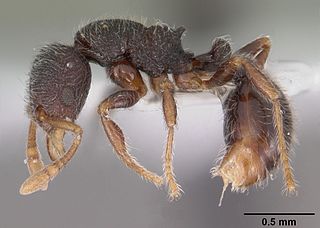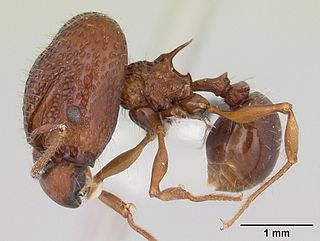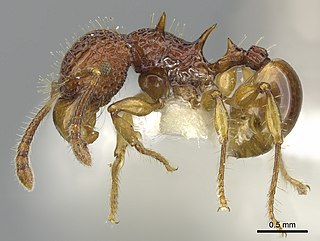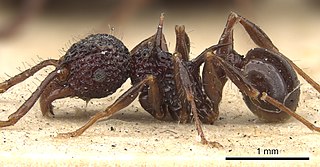
Aphaenogaster is a genus of myrmicine ants. About 200 species have been described, including 18 fossil species. They occur worldwide except in South America south of Colombia, sub-Saharan Africa, and Antarctica.

Crematogastrini is a tribe of myrmicine ants with 64 genera and 8 fossil genera.

Leptanilla is a genus of ant in the subfamily Leptanillinae. Like other genera in this subfamily, the queen is fed by the hemolymph of their own larvae, which have specialized processes for this purpose.

Lasiomyrma is a South-East Asian genus of ants in the subfamily Myrmicinae. The genus is mainly known from tropical rainforests in Sundaland.

Acanthomyrmex is a genus of ants in the subfamily Myrmicinae. The genus is known from South East Asia. Its species are dimorphic, with major workers in some genera having heads twice the length than that of the minor workers. They live in small colonies and are rarely collected in the field. There are 17 species of Acanthomyrmex.

Acanthomyrmex basispinosus is a species of ant of the genus Acanthomyrmex. It was described by Moffett in 1986, and is found in Indonesia.

Acanthomyrmex careoscrobis is a species of ant that belongs to the genus Acanthomyrmex. It was described by Moffett in 1986, and is found in Indonesia.

Acanthomyrmex concavus is a species of ant that belongs to the genus Acanthomyrmex. It was described by Moffett in 1986, and is found in Indonesia.

Acanthomyrmex crassispinus is a species of ant that belongs to the genus Acanthomyrmex. It was described by Wheeler in 1930, and is found in Taiwan.

Acanthomyrmex ferox is a species of ant that belongs to the genus Acanthomyrmex. It was described by Emery in 1893, and is found in Malaysia and Thailand.
Acanthomyrmex foveolatus is a species of ant that belongs to the genus Acanthomyrmex. It was described by Moffett in 1986, and is found in Indonesia.
Acanthomyrmex glabfemoralis is a species of ant that belongs to the genus Acanthomyrmex. It was described by Moffett in 1986, and is abundant in Vietnam and China.

Acanthomyrmex laevis is a species of ant that belongs to the genus Acanthomyrmex. It was described by Moffett in 1986, and is abundant in Malaysia.

Acanthomyrmex luciolae is a species of ant that belongs to the genus Acanthomyrmex. It was described by Emery in 1893, and is abundant in Sri Lanka and China.

Acanthomyrmex mindanao is a species of ant that belongs to the genus Acanthomyrmex. It was described by Moffett in 1986, and is abundant in Malaysia and the Philippines.
Acanthomyrmex minus is a species of ant which is a part of the genus Acanthomyrmex. Terayam, Ito & Gobin described the species in 1998, and the species is native to Indonesia.

Acanthomyrmex notabilis is a species of ant which is a part of the genus Acanthomyrmex. Frederick Smith first described the species in 1860, and it is native to Indonesia.
Acanthomyrmex padanensis is a species of ant of the genus Acanthomyrmex. Terayam, Ito & Gobin described the species in 1998, and it is native to Indonesia.

Noonilla is a genus of ants of uncertain placement in the family Formicidae. It contains the single species Noonilla copiosa, first described by Petersen in 1968 based on male specimen from the Philippines. Noonilla was initially placed in the subfamily Leptanillinae, but was later removed from the subfamily when Ogata, Terayama & Masuko (1995) reviewed the genus, leaving the genus incertae sedis in the family.













